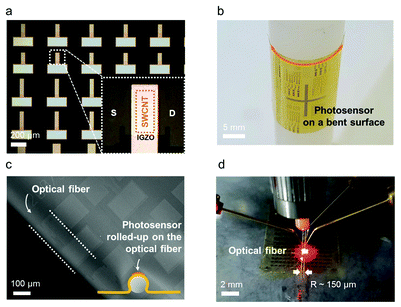 “Wide-spectral/dynamic-range skin-compatible phototransistors enabled by floated heterojunction structures with surface functionalized SWCNTs and amorphous oxide semiconductors“, I. Hwang1, J. Kim1, M. Lee2, M. Lee1, H. Kim1, H. Kwon1, D. Hwang3, M. Kim4, H. Yoon5, Y. Kim2, and S. Park1, Nanoscale 9, 16711, 2017.
“Wide-spectral/dynamic-range skin-compatible phototransistors enabled by floated heterojunction structures with surface functionalized SWCNTs and amorphous oxide semiconductors“, I. Hwang1, J. Kim1, M. Lee2, M. Lee1, H. Kim1, H. Kwon1, D. Hwang3, M. Kim4, H. Yoon5, Y. Kim2, and S. Park1, Nanoscale 9, 16711, 2017.
1. School of Electrical and Electronics Engineering, Chung-Ang University, Seoul 06974, Korea
2. School of Advanced Materials Science and Engineering and SKKU Advanced Institute of Nanotechnology (SAINT), Sungkyunkwan University, Suwon, Korea
3. Center for Opto-Electronic Materials and Devices, Post-Silicon Semiconductor Institute, Korea Institute of Science and Technology (KIST), Seoul, Korea
4. Department of Chemistry, Chung-Ang University, Seoul, Korea
5. Department of Electrical and Computer Engineering, University of Utah, Salt Lake City, USA
ABSTRACT. Purified semiconducting single-walled carbon nanotubes (sc-SWCNTs) have been researched for optoelectronic applications due to their high absorption coefficient from the visible to even the near-infrared (NIR) region. Nevertheless, the insufficient electrical characteristics and incompatibility with conventional CMOS processing have limited their wide utilization in this emerging field. Here, we demonstrate highly detective and wide spectral/dynamic range phototransistors incorporating floated heterojunction active layers which are composed of low-temperature sol–gel processed n-type amorphous indium gallium zinc oxide (a-IGZO) stacked with a purified p-type sc-SWCNT layer. To achieve a high and broad spectral/dynamic range photo-response of the heterogeneous transistors, photochemically functionalized sc-SWCNT layers were carefully implemented onto the a-IGZO channel area with a floating p–n heterojunction active layer, resulting in the suppression of parasitic charge leakage and good bias driven opto-electrical properties. The highest photosensitivity (R) of 9.6 × 102 A W−1 and a photodetectivity (D*) of 4 × 1014 Jones along with a dynamic range of 100–180 dB were achieved for our phototransistor in the spectral range of 400–780 nm including continuous and minimal frequency independent behaviors. More importantly, to demonstrate the diverse application of the ultra-flexible hybrid photosensor platform as skin compatible electronics, the sc-SWCNT/a-IGZO phototransistors were fabricated on an ultra-thin (∼1 μm) polyimide film along with a severe static and dynamic electro-mechanical test. The skin-like phototransistors showed excellent mechanical stability such as sustainable good electrical performance and high photosensitivity in a wide dynamic range without any visible cracks or damage and little noise interference after being rolled-up on the 150 μm-thick optical fiber as well as more than 1000 times cycling.

